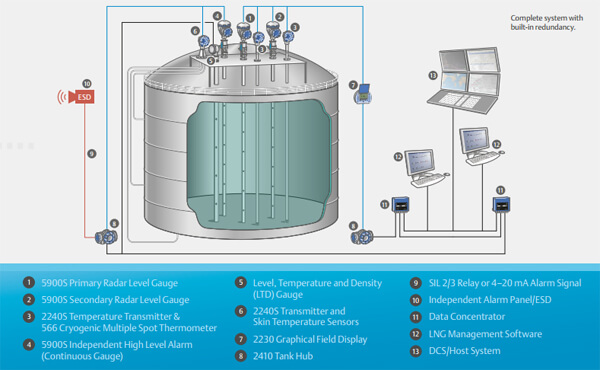Yesterday, we highlighted the role of mass-based flow measurement in liquefied natural gas (LNG) custody transfer applications. Today, I wanted to highlight the role of radar tank gauging technology in LNG tank storage applications.
 I’ll point the LNG Tank Gauging News email message I received a while back. It contains articles on integrated LNG management systems, SIL 2 and SIL 3 certified radar level gauges for overfill protection, and a YouTube overview video on LNG tank gauging by Emerson’s Ulf Johannesson. You may recall Ulf from prior tank radar-related posts here on the blog.
I’ll point the LNG Tank Gauging News email message I received a while back. It contains articles on integrated LNG management systems, SIL 2 and SIL 3 certified radar level gauges for overfill protection, and a YouTube overview video on LNG tank gauging by Emerson’s Ulf Johannesson. You may recall Ulf from prior tank radar-related posts here on the blog.
LNG is stored in large, cryogenic tanks at a temperature of -162 °C (-260 °F). Non-contacting radar is well suited in this application since the tanks may not be opened for many years. Non-contacting radar gauges, such as the Rosemount 5900S, measure the LNG level in the tank without any physical contact with the LNG surface, and without the need for inside-tank components that require service. Radar signals are transmitted inside the still-pipe, which enables the gauge to have a sufficiently strong echo even under surface boiling conditions. The 4-inch still-pipe guides the radar signal, resulting in a strong undisturbed echo from the liquid surface.
In an earlier post, Radar Level Gauges in Tank Overfill Prevention Safety Applications, we highlighted how the Raptor Tank Gauging System has attained certification for use in up to SIL 3 applications. The system includes 5900S non-contacting radar level gauges, 2240S multi-input temperature transmitters, and a 2410 tank hub which powers and collects data from the field units. This system is SIL 2 and SIL 3 certified for overfill prevention according to IEC 61508 Part 1-7. The system provides reliable high-high level alarm functionality, based on a separate SIL 2- or SIL 3-rated relay function.
As the global supply of natural gas continues to climb, the need to transport it in its liquid state continues to grow. The measurement technologies around custody transfer and storage play a critical role in continued, safe operations.

